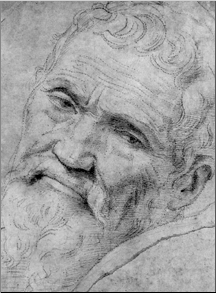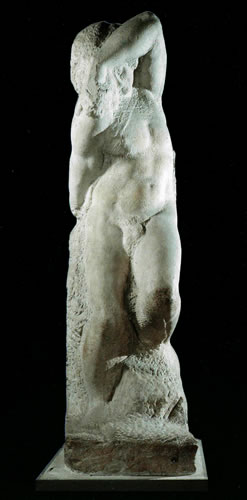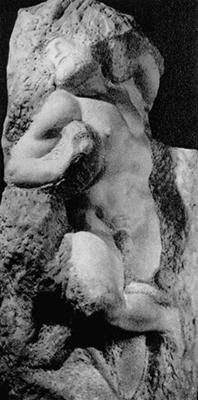![]() Guide: Music Inspired by Art
Guide: Music Inspired by Art
>Listen to the complete song cycle on this website

Michelangelo’s Poetry in Translation
The poems were composed in strict meter and rhyme, and while some English translations recreate this (notably those by Sidney Alexander) I was attracted to the more prose-like translations of James M. Saslow based on their clarity of meaning and dramatic pacing. However, as I began work on the music, I found that Saslow’s word choice and syntax did not always work ideally with music—with the exception of the first selection in this cycle, which I found to fit perfectly and have used without alteration. For the other poems, I adapted the text into my own words, consulting Saslow and Alexander, and occasionally the original Italian (which I can’t read, but felt through with a dictionary and some guesswork!).
While I took a great deal of stylistic liberty with the language and poetic meter, I strove always to retain the essential meaning of the poems and to deliver Michelangelo’s metaphors intact. More often than not I have liberally truncated his complex, interweaving syntax into concise phrases that can be more easily understood in real-time performance. I hope that I have been able to adapt Michelangelo’s ideas into a form that might illuminate them in a new and meaningful way for the audience.
Comparing the Texts
To give a sense of how similar (or dissimilar) the poems in this cycle are to the originals, here are excerpts from Michelangelo’s original Italian poems, English translations by a published scholar, and my own adaptations.
In this first excerpt, I makes the four lines of this stanza rhyme rhythmically (although the words do not), which allows for a “song-like” setting.
Michelangelo’s Original
Passo inanzi a me stesso
con alto e buon concetto,
e ‘l tempo gli prometto
c’aver non deggio.
Excerpt, poem 144 [Girardi numbering]
Translation by James M. Saslow
From The Poetry of Michelangelo, An Annotated Translation. Yale University Press, 1991.
I get ahead of myself
with a lofty and fine conception,
and promise it the time
that I’m not to have.
Nell Shaw Cohen’s adaptation (“The Years I Cannot Know“)
I plan for the time that I will not have
to realize a lofty goal.
I promise myself completion
in the years I cannot know.
In this next example, I took only the essential meaning behind the poem and dramatically altered the rhythm of the text in order to suit my purposes in setting the words to music.
Michelangelo’s Original
S’egli è che ‘n dura pietra alcun somigli
talor l’immagin d’ogni altri a se stesso,
squalido e smorto spresso,
il fo, com’ i’ son fattoda costei.
E par ch’esempro pigli
ognor da me, chi’ i’ penso di far lei.
Excerpt, poem 242 [Girardi numbering]
Translation by James M. Saslow
From The Poetry of Michelangelo, An Annotated Translation. Yale University Press, 1991.
Since it’s true that, in hard stone, one will at times
make the image of someone else look like himself,
I often make her dreary
and ashen, just as I’m made by this woman;
and I seem to keep taking myself
as a model, whenever I think of depicting her.
Nell Shaw Cohen’s adaptation (“I Become the Model“)
Sometimes one will make
the image of someone else
look like the image of himself.
So, I make her gloomy just as she makes me.
I become the model whenever I model her.
In the following example, I stayed much closer to Saslow’s language, choosing to collapse some of the poetic syntax into simpler phrases.
Michelangelo’s Original
sì che mill’ anni dopo la partita,
quante voi bella fusti e quant’ io lasso
si veggia, e com’ armarvi i’ non fu’ stolto.
Excerpt, poem 239 [Girardi numbering]
Translation by James M. Saslow
Excerpted from The Poetry of Michelangelo, An Annotated Translation. Yale University Press, 1991.
so that a thousand years after our departure
may be seen how lovely you were, and how wretched I,
and how, in loving you, I was no fool.
Nell Shaw Cohen’s adaptation (“A Thousand Years After We Are Gone”)
so that a thousand years after we are gone
all can see how lovely you were,
and how pathetic I was,
and that I was no fool in loving you.
>Listen to the complete song cycle on this website



